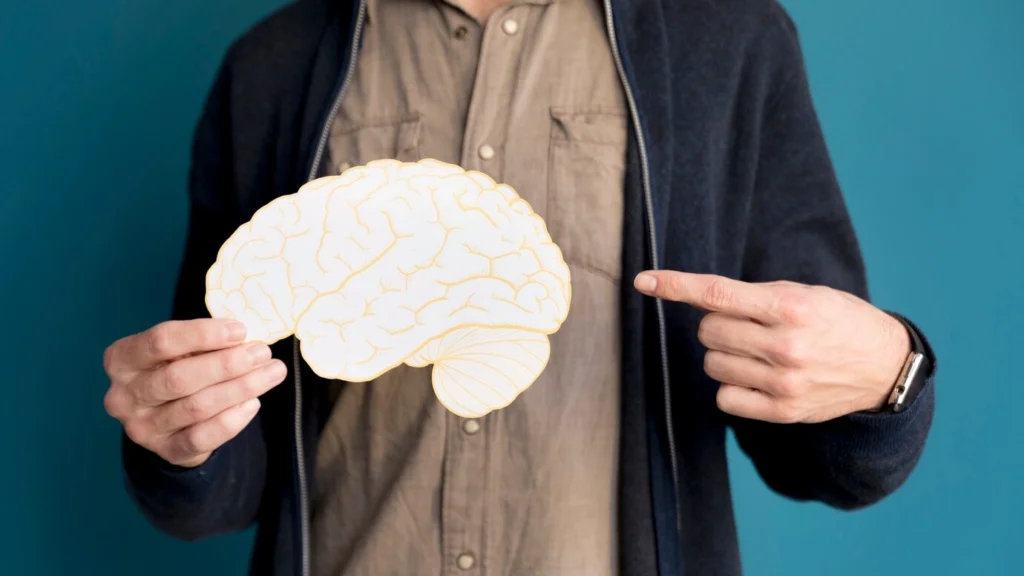
Addiction & Trauma Recovery Center
Licensed by Thai Ministry of Health #84-03-00294
The Science of Addiction: How Drugs Hijack the Brain
Understanding the Brain’s Reward System
To understand how addiction affects the brain, it’s important to first examine the brain’s reward system. This system is responsible for reinforcing behaviors that are essential for survival, such as eating, socializing, and reproduction.
How the Brain’s Reward System Works
- The brain releases dopamine, a neurotransmitter associated with pleasure and motivation, in response to enjoyable activities.
- This dopamine surge reinforces behaviors, making us more likely to repeat them.
- Over time, the brain associates these activities with positive feelings, creating habit loops.
However, when drugs enter the picture, they hijack this natural system, leading to addiction.
When drugs are introduced, they flood the brain with dopamine at levels far higher than those produced by natural rewards, creating an intense but artificial sense of euphoria. Over time, the brain adapts to these excessive dopamine levels by reducing its own production of the neurotransmitter and decreasing the number of dopamine receptors.
This leads to tolerance, where the individual needs more of the drug to achieve the same effect, and dependence, where the brain struggles to function normally without the substance. Additionally, the prefrontal cortex, which is responsible for decision-making and impulse control, becomes impaired, making it increasingly difficult for individuals to resist cravings or prioritize long-term well-being over immediate gratification.
This hijacking of the brain’s reward system not only drives the cycle of addiction but also makes recovery a challenging process that requires time, support, and often medical intervention to restore balance.

How Drugs Rewire the Brain
When a person uses drugs, they trigger an unnatural flood of dopamine, creating an intense euphoria. However, repeated use alters brain chemistry, leading to long-term consequences.
How Drugs Change Brain Chemistry and Cause Addiction
- Drugs Overstimulate the Brain – Substances like opioids, cocaine, and methamphetamine cause massive dopamine surges that the brain cannot produce naturally.
- Dopamine Receptors Become Damaged – With repeated drug use, the brain reduces dopamine receptor availability, making it harder to feel pleasure from natural rewards.
- The Brain Begins Craving More – Over time, the brain requires more of the drug to achieve the same effect, leading to compulsive use.
Drug Impact on Brain Reward System
- Opioids (Heroin, Fentanyl, Oxycodone) – Bind to receptors that control pain and pleasure, slowing down respiration and creating dependency.
- Stimulants (Cocaine, Meth, Adderall) – Overload the dopamine system, causing a short-lived high followed by extreme depression and cravings.
- Depressants (Alcohol, Benzodiazepines) – Suppress brain activity, leading to tolerance and dangerous withdrawal symptoms.
Because of these changes, addiction is not simply a lack of willpower—it’s a neurological disorder.
Chronic drug use not only disrupts the reward system but also activates the brain’s stress pathways, particularly the release of cortisol and other stress hormones. This creates a vicious cycle where individuals use drugs to escape stress, only to experience heightened anxiety and irritability during withdrawal, driving them to use again.
Additionally, drugs impair the function of the prefrontal cortex, the part of the brain responsible for decision-making, self-control, and judgment. This impairment makes it increasingly difficult for individuals to resist cravings or make rational choices about drug use, even when they are aware of the negative consequences. Over time, these changes can lead to a state where drug use becomes automatic and compulsive, further entrenching the addiction.
Understanding these neurological changes highlights the importance of comprehensive treatment approaches that address both the physical and psychological aspects of addiction, helping individuals regain control over their brain’s reward and stress systems.

The Difference Between Tolerance, Dependence, and Addiction
Understanding the Key Differences
Many people confuse tolerance, dependence, and addiction, but they are distinct stages of substance use disorder.
- Tolerance – The body becomes used to a drug, requiring higher doses for the same effect.
- Dependence – The brain relies on the substance to function normally, leading to withdrawal symptoms if stopped.
- Addiction – A chronic condition where drug use continues despite negative consequences, driven by changes in brain chemistry.
Why Addiction is a Disease and Not a Choice
- Brain imaging studies show that addiction physically alters brain structures, affecting impulse control and decision-making.
- People with addiction experience compulsions similar to those seen in other neurological disorders.
- Genetics and environment play a significant role, making some individuals more susceptible.
Since addiction rewires the brain, recovery requires much more than willpower—it demands medical intervention and therapy.
An important distinction between tolerance, dependence, and addiction lies in their progression and the challenges they present for recovery. Tolerance often develops first, as the body adapts to the presence of a drug, reducing its effectiveness over time. This can lead individuals to increase their dosage, inadvertently accelerating the progression to dependence.
Dependence occurs when the brain and body adapt to the drug to such an extent that they struggle to function without it, resulting in withdrawal symptoms when the substance is reduced or stopped. These symptoms can range from mild discomfort to severe physical and psychological distress, making it difficult for individuals to quit on their own.
Addiction, the most severe stage, involves not only physical dependence but also a psychological compulsion to use the drug, often despite devastating consequences to one’s health, relationships, and livelihood. This progression underscores the importance of early intervention and comprehensive treatment that addresses both the physical and psychological aspects of substance use disorder, helping individuals break free from the cycle of addiction and rebuild their lives.
Can the Brain Heal from Addiction?
Can the Brain Recover After Long-Term Drug Abuse?
The brain is highly adaptable thanks to neuroplasticity, the ability to form new neural connections. However, recovery depends on several factors, including:
- The duration and severity of drug use – Long-term drug use can cause irreversible damage, but recovery is still possible.
- Age and overall health – Younger brains tend to recover faster.
- Therapy and treatment – Structured rehabilitation programs help the brain heal faster.
Neuroplasticity in Addiction Recovery
Although drugs damage the brain’s reward system, the brain has the ability to rewire itself over time.
- With sustained abstinence, dopamine receptors gradually recover.
- Cognitive Behavioral Therapy (CBT) helps reprogram the brain’s response to triggers.
- Physical exercise and nutrition support neurological healing.
While recovery is possible, it requires time, commitment, and medical support.
Strong relationships with family, friends, and support groups can provide emotional stability and encouragement, which are essential for rebuilding healthy neural pathways. Additionally, engaging in meaningful activities, such as hobbies, volunteering, or pursuing educational and career goals, can help the brain form new, positive associations that replace the old patterns linked to drug use.
Mindfulness practices, such as meditation and yoga, have also been shown to enhance neuroplasticity by reducing stress and improving emotional regulation, which are often significant barriers to recovery. Furthermore, medications used in Medication-Assisted Treatment (MAT) can help stabilize brain chemistry during the early stages of recovery, making it easier for individuals to engage in therapy and other healing activities.
By combining these approaches, individuals can create a holistic recovery plan that supports the brain’s natural ability to heal and adapt, paving the way for a healthier, drug-free future.
The Role of Therapy in Brain Recovery
Since addiction alters the brain, treatment must address both physical and psychological aspects of recovery.
Key Therapies for Brain Recovery
1. Cognitive Behavioral Therapy (CBT)
- Helps individuals recognize and change negative thought patterns.
- Teaches coping mechanisms to resist cravings and prevent relapse.
2. Medication-Assisted Treatment (MAT)
- Methadone, Buprenorphine (Suboxone), and Naltrexone help stabilize brain chemistry in opioid addiction.
- Anti-craving medications can support alcohol and nicotine addiction recovery.
3. Mindfulness and Stress Reduction
- Meditation and mindfulness help retrain the brain to manage stress without substances.
- Yoga, breathing exercises, and biofeedback improve emotional regulation.
Support Groups and Long-Term Care
- 12-Step Programs (AA, NA) – Offer peer support and accountability.
- SMART Recovery – Uses scientific methods to promote long-term recovery.
By combining therapy, medication, and lifestyle changes, individuals can repair the damage caused by addiction.
Conditions like depression, anxiety, and post-traumatic stress disorder (PTSD) often contribute to substance abuse and can hinder recovery if left untreated. Integrated treatment approaches, such as Dual Diagnosis Therapy, simultaneously address addiction and mental health issues, providing a more comprehensive path to healing.
For example, trauma-focused therapies like Eye Movement Desensitization and Reprocessing (EMDR) can help individuals process past experiences that may have led to substance use, while Dialectical Behavior Therapy (DBT) can teach skills for managing intense emotions and improving interpersonal relationships.
Additionally, family therapy can repair relationships damaged by addiction and create a supportive home environment that fosters recovery. By addressing the root causes of addiction and providing tools for emotional and psychological resilience, therapy plays a vital role in helping individuals rebuild their lives and sustain long-term sobriety.
FAQs About Addiction and Brain Health
Why is addiction considered a brain disease?
Addiction physically alters brain chemistry and structure, leading to compulsive drug-seeking behavior. It is classified as a chronic neurological disorder, not a moral failing.
Another reason addiction is considered a brain disease is its impact on the brain’s decision-making and self-control centers, particularly the prefrontal cortex. This area of the brain, responsible for impulse control, judgment, and rational decision-making, becomes impaired with prolonged substance use.
As a result, individuals struggling with addiction often find it difficult to resist cravings or make choices that prioritize their long-term well-being over immediate drug use. These changes are visible in brain imaging studies, which show reduced activity and structural differences in the prefrontal cortex of individuals with addiction compared to those without.
Furthermore, addiction shares many characteristics with other chronic diseases, such as hypertension or diabetes, including the potential for relapse and the need for ongoing management. Recognizing addiction as a brain disease helps reduce stigma, encouraging a more compassionate and science-based approach to treatment that focuses on healing and recovery rather than blame or punishment.
How do drugs alter brain function?
Drugs flood the brain with dopamine, rewiring the reward system and impairing impulse control. Over time, the brain becomes dependent on substances to feel normal.
Chronic drug use can overactivate the amygdala, the brain’s fear and stress center, leading to heightened anxiety, irritability, and difficulty managing emotions. At the same time, drugs suppress the function of the hippocampus, which is involved in memory and learning, making it harder for individuals to recall the negative consequences of their drug use or learn from past experiences.
This combination of heightened stress and impaired memory creates a cycle where individuals turn to drugs to cope with emotional distress, only to experience even greater stress during withdrawal. Additionally, drugs can damage the brain’s white matter, which is responsible for communication between different brain regions, further impairing cognitive functions like decision-making, problem-solving, and self-control.
These widespread changes in brain function underscore the complexity of addiction and the need for comprehensive treatment that addresses both the neurological and psychological aspects of the disorder.
Can the brain recover from addiction?
Yes, but it takes time. Through neuroplasticity, therapy, and medical treatment, the brain can repair damaged pathways and regain normal function.
Also an important factor in the brain’s recovery from addiction is the role of lifestyle changes in supporting neuroplasticity and overall brain health. Regular physical exercise, for example, has been shown to increase the production of brain-derived neurotrophic factor (BDNF), a protein that promotes the growth and repair of neurons.
Similarly, a balanced diet rich in essential nutrients, such as omega-3 fatty acids, antioxidants, and vitamins, can support cognitive function and reduce inflammation in the brain, which is often heightened by chronic drug use. Adequate sleep is also crucial, as it allows the brain to consolidate memories, process emotions, and repair itself.
Additionally, engaging in mentally stimulating activities, such as learning new skills or hobbies, can help rebuild neural connections and improve cognitive flexibility. By adopting a holistic approach that combines medical treatment, therapy, and healthy lifestyle choices, individuals can enhance their brain’s natural ability to heal and increase their chances of achieving long-term recovery.
Conclusion
Understanding how addiction affects the brain highlights why substance use disorder is a neurological condition, not a choice. Drugs rewire brain chemistry, leading to dependence and compulsive behavior.
However, thanks to neuroplasticity in addiction recovery, the brain can heal. With therapy, medication-assisted treatment, and long-term support, recovery is possible.
If you or a loved one is struggling with addiction, seeking professional help is the first step toward healing.
While neuroplasticity allows the brain to heal, a supportive environment can significantly enhance the recovery process. This includes building a strong network of family, friends, and peers who understand the challenges of addiction and provide encouragement and accountability.
Community-based programs, such as sober living homes and recovery-focused organizations, can offer a safe and structured environment that reduces exposure to triggers and promotes healthy habits. Additionally, addressing co-occurring issues like trauma, unemployment, or housing instability through integrated care can help individuals rebuild their lives and reduce the risk of relapse.
By combining neurological healing with social and environmental support, individuals can create a comprehensive recovery plan that not only restores brain function but also fosters a fulfilling and sustainable drug-free life.





















